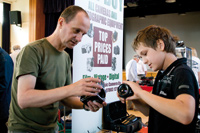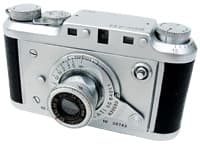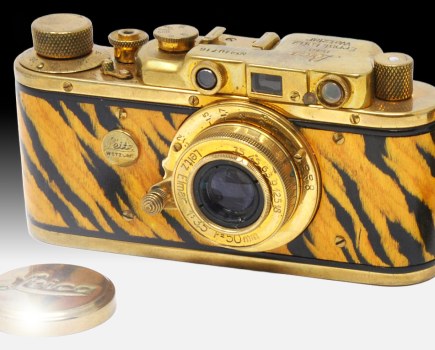Lively, buoyant and flourishing – the world of second-hand camera trading is very much alive and kicking. This is good news for camera dealers like Robert Smith, who lives in Horndean, Hampshire, where he has been running his business, The Vintage & Classic Camera Co, for the past ten years.
Trading high-quality camera equipment all over the world, Robert buys and sells a vast array of cameras and lenses, from 35mm SLRs to half-frame, folding, medium-format and large-format cameras, plus pretty much everything in between.
Having studied photography at art college, Robert revisited his photographic roots in his early 30s when he decided to put together a small collection of cameras he’d picked up from car-boot sales.
‘I’d amassed a few cameras and one day decided to sell them,’ he says. ‘I made a profit, so I started buying and selling cameras more regularly. I looked in local newspapers and went to car-boot sales, auctions, antique fairs, charity shops and camera shops that sold second-hand equipment, picking up all sorts of cameras and then selling them at camera fairs or on eBay. When I was made redundant I decided to put the redundancy money into growing the camera business. We launched the website two years ago and business went from strength to strength.’

Image: Robert Smith: The Vintage and Classic Camera Co. Robert sells a wide range of classic and vintage camera equipment
Second-hand treasures
The second-hand camera market has always had its place in the world of photography, but in the past couple of years the industry has burgeoned beyond belief – perhaps due in part to photographers switching to digital systems and trading in their old film cameras or rediscovering the joy of using film.
Whatever the reason, the increased interest in buying second-hand is heartening.
Robert sells cameras to photographers from all backgrounds, including camera enthusiasts, serious collectors, students and professional photographers who are just starting out.
His customers range from those who want to get out and use the cameras to those who prefer to polish their treasures and keep them locked away in a display cabinet.
‘Some people buy to get back the cameras they had as youngsters,’ says Robert. ‘They might be looking to reunite themselves with their first camera or maybe buy the camera they couldn’t afford when they were young. Then there are the hardened collectors who are trying to plug holes or improve the quality of their collection, and finally students who have grown up in a digital age and are discovering film for the first time. Cameras from the 1960s through to the early ’90s tend to be more user-based, but cameras from the ’60s and earlier are often more sought-after by collectors.’
What sells?
 Always looking to source only the highest quality models, the range of cameras Robert has is in stock at any one time is vast.
Always looking to source only the highest quality models, the range of cameras Robert has is in stock at any one time is vast.
‘We stock cameras from the 1870s to the 1990s or thereabouts,’ says Robert. This is anything and everything, from early wooden cameras to 35mm, medium and large-format, among others. I’m always searching for cameras that are in an excellent condition. It matters less which year they were made, but they must be top quality.
 ‘The earliest camera we’ve sold was from around 1865-70. It was a Murray & Heath sliding box camera with connections to Fox Talbot, which was a really valuable piece. That’s also probably the most expensive camera I’ve sold.
‘The earliest camera we’ve sold was from around 1865-70. It was a Murray & Heath sliding box camera with connections to Fox Talbot, which was a really valuable piece. That’s also probably the most expensive camera I’ve sold.
‘There are a lot of beautiful collections out there, which don’t come around very often, and the cameras from these collections are quite rare. The most sought-after cameras are those from the earliest days of photography, and also early and rare Leica cameras and lenses. Using adapters, the Leica lenses can be used with modern cameras so people are rediscovering these wonderful optics. Rolleiflex cameras are also popular.
‘I’ve just bought a couple of Ducati Sogno half-frame 35mm rangefinders made by the motorcycle manufacturer Ducati Meccanica,’ continues Robert. ‘You could say they’re akin to a miniature Leica copy, with interchangeable lenses, a similar build quality and design. They’re really sought-after, so I’m always looking to get these cameras in. I’ve only sold four in my career.’

Image: A Ducati Sogno 35mm miniature rangefinder made by the Italian motorcycle manufacturer Ducati Meccanica
‘With so many exciting cameras coming and going, unsurprisingly there has been the odd one that Robert wishes he could have kept for himself. ‘Very early on I bought a Rayflex 3 prototype camera from a junk shop for £20. I sold that on and would love to get it back one day,’ says Robert.
Community spirit
‘Most of the collectors and dealers know one another and the community within the Photographic Collectors’ Club of Great Britain (PCCGB) is especially active,’ says Robert. ‘If a camera dealer buys a large collection, most often others will want a piece of the action and the collection will be broken up and could end up over the world.’
Sometimes Robert will come across a camera he has sold years later.
‘I might sell a camera to someone at a camera fair and two or three years later I’ll see it on another dealer’s bench and have the chance to buy it back,’ he says. ‘Most collectors start by buying everything, but soon the collection becomes difficult to manage so the collector then focuses on a particular brand or style of camera. They’ll start selling the cameras that don’t fit with their criteria. There are so many weird and wonderful cameras I’ve come across – pistol cameras, detective cameras that can be concealed in a coat pocket, Ticka watch cameras and Devin Tricolor cameras. You never know what you’ll find.’
Renewed interest
Robert believes there are several reasons for the revived interest in film cameras. ‘People are rediscovering the magic of using film,’ he says. ‘There’s the excitement of taking a film to be developed and waiting to see what you’ve captured or, if you’re developing the film yourself, waiting for the images to appear.
‘The second-hand camera market is really buoyant at the moment,’ he adds. ‘At the end of the day it’s treasure hunting. It’s not about the money – it’s about finding special cameras to own.’
Perils & pitfalls
‘The condition of the camera is crucial,’ says Robert. ‘Check for dents and scratches or signs of corrosion, and that lenses are clear with no haze or fungus. With cameras from the ’70s and ’80s in particular, check the light trappings to make sure these are intact as they can degrade over time, and that all the electronics are functioning properly. Buying cameras from the ’60s and earlier is easier as there are few electronics to go wrong.
‘At the upper end of the value scale you need to be alert to fakes. When a camera is so rare that only a few people have ever seen or handled an example, there is an opportunity for the accomplished engineer/faker. It’s not a huge problem if you’re vigilant.
‘Every camera has its own things you should check. For example, if you’re buying a Rolleiflex with a Planar or Xenotar lens, check for balsam separation in the optics. This will appear as a billowing rainbow effect in the glass, usually coming in from the outer edges. It is where the balsam that was used to fix the lens elements together has separated and will require a costly repair.
‘If you’re looking for a Leica, see how it operates at the slower shutter speeds to make sure they don’t stick.
‘On a rangefinder camera, make sure the double image is strong and properly aligned. For wood and brass cameras, check to see they haven’t been adapted. These cameras often evolved over the period of their working life as advancements in technology were made and retrofitted by the owner. Originality is paramount.’
Camera fairs
 Robert is an avid supporter of fairs. Some of the main ones are at Wolverhampton in the West Midlands, Frome in Somerset, Beaconsfield in Buckinghamshire, Potters Bar in Hertfordshire, Guildford in Surrey, Sidcup in Greater London and, of course, Photographica, the UK’s largest camera collectors’ and users’ fair.
Robert is an avid supporter of fairs. Some of the main ones are at Wolverhampton in the West Midlands, Frome in Somerset, Beaconsfield in Buckinghamshire, Potters Bar in Hertfordshire, Guildford in Surrey, Sidcup in Greater London and, of course, Photographica, the UK’s largest camera collectors’ and users’ fair.
‘Camera fairs are a great source of stock and if they disappear we’re letting part of the industry die,’ he says. ‘Fairs are a great place to buy cameras because you can handle the item before you buy it, then agree a price with the vendor. The guys selling the cameras are specialists in their field and are happy to advise. You can pick up high-quality cameras for less than at certain auction sites, and have peace of mind knowing that the person who has sold it to you knows what he’s selling.’
Peter Levinson is the man behind the fairs at Beaconsfield, Guildford and Potter’s Bar. ‘We started them in 1994,’ he says, ‘and run 11 a year. Those at Potters Bar and Beaconsfield run four times a year, and in Guildford three times. We usually have between 35 and 40 tables at a show with up to 200 visitors.
‘We’re seeing a lot of younger people at the fairs,’ Peter continues, ‘especially photography students. A lot of the stallholders are regulars at the fairs, but we sometimes have individuals who sell privately. It’s a friendly atmosphere and, although people buy second-hand camera equipment on the internet, nothing beats seeing and holding the item before you buy.’
To find out more about Peter’s fairs, call 0208 205 1518.







